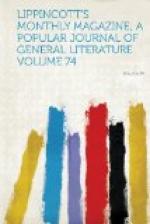She came on, her eyes always fixed on the distance, seeing nothing of Alick standing dark against the sky. She came nearer, nearer, till he saw the glory of her eyes, the curve of her lip, and could count the curling tresses on her brow. Then he came down from the height and strode across the space between them.
She lifted up her eyes and saw him. For an instant the sadness cleared out of them as the mists had cleared from the sky: her pathetic mouth broke into a smile, and she held out both her hands. “Alick, dear Alick! my good Alick!” she cried in a voice of exquisite tenderness.
“My queen!” he said kneeling, his honest upturned face wet with tears. “Lost and now found!”
[TO BE CONTINUED.]
THE ITALIAN MEDIAEVAL WOOD-SCULPTORS.
More or less during the whole of this century, and ever more during the recent years of it, the love of art, especially in what have been called the “industrial” manifestations of it, has been becoming a passion in Germany and in France, as well as in England and America. Museums for the collection and preservation of the works produced by the artists of those centuries which were the palmy days of art have been established in all these countries, and private amateurs have vied with them in enriching their respective countries with specimens of all the many kinds of art-industry which remain to us from those times when religion encouraged and surrounded itself with the beautiful and the cultivation of the beautiful was a religion. And it is mainly—indeed, almost entirely—to Italy that the lovers and admirers of mediaeval art come in search of those remains of it which, it is hoped, will be (or rather are being) the means of producing a second art renaissance. The quantity of objects, more or less genuinely representing the mediaeval art in all its many branches, which has been carried out of Italy within the last quarter of a century is something perfectly astounding, and far exceeds what any one would believe who has not remained in Italy long enough to observe the process. A considerable portion, no doubt, of the articles thus carried home with them by the lovers of art has consisted of modern imitations of ancient workmanship, but the quantity of genuine mediaeval articles—pottery in its various kinds, furniture, carving in wood, in marble, in stone and in ivory, lace, bronzes, embroidery, metal-work, brocaded stuffs, etc.—has been so enormous as to reveal in a very striking manner the extraordinary wealth of the country in the days when it was the mistress of Europe in civilization, and the all-pervading love of the beautiful which caused so very large a portion of that wealth to be expended for the gratification of a refined taste.




